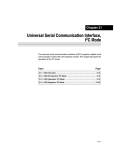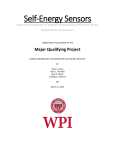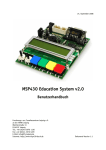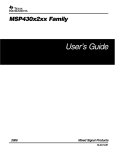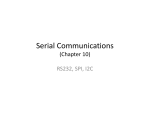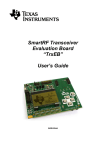Download MSP430x4xx Family User's Guide (Rev. G - webwww03
Transcript
Chapter 20
Universal Serial Communication Interface,
SPI Mode
The universal serial communication interface (USCI) supports multiple serial
communication modes with one hardware module. This chapter discusses the
operation of the synchronous peripheral interface or SPI mode.
Topic
Page
20.1 USCI Overview . . . . . . . . . . . . . . . . . . . . . . . . . . . . . . . . . . . . . . . . . . . . . . . 20-2
20.2 USCI Introduction: SPI Mode . . . . . . . . . . . . . . . . . . . . . . . . . . . . . . . . . . 20-3
20.3 USCI Operation: SPI Mode . . . . . . . . . . . . . . . . . . . . . . . . . . . . . . . . . . . . 20-5
20.4 USCI Registers: SPI Mode . . . . . . . . . . . . . . . . . . . . . . . . . . . . . . . . . . . 20-14
Universal Serial Communication Interface, SPI Mode
20-1
USCI Overview
20.1 USCI Overview
The universal serial communication interface (USCI) modules support
multiple serial communication modes. Different USCI modules support
different modes. Each different USCI module is named with a different letter.
For example, USCI_A is different from USCI_B, etc. If more than one identical
USCI module is implemented on one device, those modules are named with
incrementing numbers. For example, if one device has two USCI_A modules,
they are named USCI_A0 and USCI_A1. See the device-specific data sheet
to determine which USCI modules, if any, are implemented on which devices.
The USCI_Ax modules support:
-
UART mode
Pulse shaping for IrDA communications
Automatic baud rate detection for LIN communications
SPI mode
The USCI_Bx modules support:
- I2C mode
- SPI mode
20-2
Universal Serial Communication Interface, SPI Mode
USCI Introduction: SPI Mode
20.2 USCI Introduction: SPI Mode
In synchronous mode, the USCI connects the MSP430 to an external system
via three or four pins: UCxSIMO, UCxSOMI, UCxCLK, and UCxSTE. SPI
mode is selected when the UCSYNC bit is set and SPI mode (3-pin or 4-pin)
is selected with the UCMODEx bits.
SPI mode features include:
- 7- or 8-bit data length
- LSB-first or MSB-first data transmit and receive
- 3-pin and 4-pin SPI operation
- Master or slave modes
- Independent transmit and receive shift registers
- Separate transmit and receive buffer registers
- Continuous transmit and receive operation
- Selectable clock polarity and phase control
- Programmable clock frequency in master mode
- Independent interrupt capability for receive and transmit
- Slave operation in LPM4
Figure 20−1 shows the USCI when configured for SPI mode.
Universal Serial Communication Interface, SPI Mode
20-3
USCI Introduction: SPI Mode
Figure 20−1. USCI Block Diagram: SPI Mode
Receive State Machine
Set UCOE
Set UCxRXIFG
UCLISTEN
UCMST
Receive Buffer UCxRXBUF
UCxSOMI
0
Receive Shift Register
1
1
0
UCMSB UC7BIT
UCSSELx
Bit Clock Generator
UCCKPH UCCKPL
UCxBRx
N/A
00
ACLK
01
SMCLK
10
SMCLK
11
16
BRCLK
Prescaler/Divider
Clock Direction,
Phase and Polarity
UCxCLK
UCMSB UC7BIT
UCxSIMO
Transmit Shift Register
UCMODEx
2
Transmit Buffer UCxTXBUF
Transmit Enable
Control
UCxSTE
Set UCFE
Transmit State Machine
Set UCxTXIFG
20-4
Universal Serial Communication Interface, SPI Mode
USCI Operation: SPI Mode
20.3 USCI Operation: SPI Mode
In SPI mode, serial data is transmitted and received by multiple devices using
a shared clock provided by the master. An additional pin, UCxSTE, is provided
to enable a device to receive and transmit data and is controlled by the master.
Three or four signals are used for SPI data exchange:
- UCxSIMO
Slave in, master out
Master mode: UCxSIMO is the data output line.
Slave mode: UCxSIMO is the data input line.
- UCxSOMI
Slave out, master in
Master mode: UCxSOMI is the data input line.
Slave mode: UCxSOMI is the data output line.
- UCxCLK
USCI SPI clock
Master mode: UCxCLK is an output.
Slave mode: UCxCLK is an input.
- UCxSTE
Slave transmit enable. Used in 4-pin mode to allow multiple
masters on a single bus. Not used in 3-pin mode. Table 20−1
describes the UCxSTE operation.
Table 20−1.UCxSTE Operation
UCMODEx
UCxSTE Active State
01
high
10
low
UCxSTE
Slave
Master
0
inactive
active
1
active
inactive
0
active
inactive
1
inactive
active
Universal Serial Communication Interface, SPI Mode
20-5
USCI Operation: SPI Mode
20.3.1 USCI Initialization and Reset
The USCI is reset by a PUC or by the UCSWRST bit. After a PUC, the
UCSWRST bit is automatically set, keeping the USCI in a reset condition.
When set, the UCSWRST bit resets the UCxRXIE, UCxTXIE, UCxRXIFG,
UCOE, and UCFE bits and sets the UCxTXIFG flag. Clearing UCSWRST
releases the USCI for operation.
Note: Initializing or Re-Configuring the USCI Module
The recommended USCI initialization/re-configuration process is:
1) Set UCSWRST (BIS.B #UCSWRST,&UCxCTL1)
2) Initialize all USCI registers with UCSWRST=1 (including UCxCTL1)
3) Configure ports.
4) Clear UCSWRST via software (BIC.B
#UCSWRST,&UCxCTL1)
5) Enable interrupts (optional) via UCxRXIE and/or UCxTXIE
20.3.2 Character Format
The USCI module in SPI mode supports 7- and 8-bit character lengths
selected by the UC7BIT bit. In 7-bit data mode, UCxRXBUF is LSB justified
and the MSB is always reset. The UCMSB bit controls the direction of the
transfer and selects LSB or MSB first.
Note: Default Character Format
The default SPI character transmission is LSB first. For communication with
other SPI interfaces it MSB-first mode may be required.
Note: Character Format for Figures
Figures throughout this chapter use MSB first format.
20-6
Universal Serial Communication Interface, SPI Mode
USCI Operation: SPI Mode
20.3.3 Master Mode
Figure 20−2. USCI Master and External Slave
MASTER
Receive Buffer
UCxRXBUF
UCxSIMO
SLAVE
SIMO
Transmit Buffer
UCxTXBUF
SPI Receive Buffer
Px.x
UCxSTE
Receive Shift Register
Transmit Shift Register
UCx
SOMI
UCxCLK
MSP430 USCI
STE
SS
Port.x
SOMI
Data Shift Register (DSR)
SCLK
COMMON SPI
Figure 20−2 shows the USCI as a master in both 3-pin and 4-pin
configurations. The USCI initiates data transfer when data is moved to the
transmit data buffer UCxTXBUF. The UCxTXBUF data is moved to the TX shift
register when the TX shift register is empty, initiating data transfer on
UCxSIMO starting with either the most-significant or least-significant bit
depending on the UCMSB setting. Data on UCxSOMI is shifted into the receive
shift register on the opposite clock edge. When the character is received, the
receive data is moved from the RX shift register to the received data buffer
UCxRXBUF and the receive interrupt flag, UCxRXIFG, is set, indicating the
RX/TX operation is complete.
A set transmit interrupt flag, UCxTXIFG, indicates that data has moved from
UCxTXBUF to the TX shift register and UCxTXBUF is ready for new data. It
does not indicate RX/TX completion.
To receive data into the USCI in master mode, data must be written to
UCxTXBUF because receive and transmit operations operate concurrently.
Universal Serial Communication Interface, SPI Mode
20-7
USCI Operation: SPI Mode
Four-Pin SPI Master Mode
In 4-pin master mode, UCxSTE is used to prevent conflicts with another
master and controls the master as described in Table 20−1. When UCxSTE
is in the master-inactive state:
- UCxSIMO and UCxCLK are set to inputs and no longer drive the bus
- The error bit UCFE is set indicating a communication integrity violation to
be handled by the user.
- The internal state machines are reset and the shift operation is aborted.
If data is written into UCxTXBUF while the master is held inactive by UCxSTE,
it will be transmit as soon as UCxSTE transitions to the master-active state.
If an active transfer is aborted by UCxSTE transitioning to the master-inactive
state, the data must be re-written into UCxTXBUF to be transferred when
UCxSTE transitions back to the master-active state. The UCxSTE input signal
is not used in 3-pin master mode.
20-8
Universal Serial Communication Interface, SPI Mode
USCI Operation: SPI Mode
20.3.4 Slave Mode
Figure 20−3. USCI Slave and External Master
MASTER
SIMO
SLAVE
UCxSIMO
Transmit Buffer
UCxTXBUF
Receive Buffer
UCxRXBUF
Transmit Shift Register
Receive Shift Register
SPI Receive Buffer
Data Shift Register DSR
Px.x
UCxSTE
STE
SS
Port.x
SOMI
SCLK
UCx
SOMI
UCxCLK
COMMON SPI
MSP430 USCI
Figure 20−3 shows the USCI as a slave in both 3-pin and 4-pin configurations.
UCxCLK is used as the input for the SPI clock and must be supplied by the
external master. The data-transfer rate is determined by this clock and not by
the internal bit clock generator. Data written to UCxTXBUF and moved to the
TX shift register before the start of UCxCLK is transmitted on UCxSOMI. Data
on UCxSIMO is shifted into the receive shift register on the opposite edge of
UCxCLK and moved to UCxRXBUF when the set number of bits are received.
When data is moved from the RX shift register to UCxRXBUF, the UCxRXIFG
interrupt flag is set, indicating that data has been received. The overrun error
bit, UCOE, is set when the previously received data is not read from
UCxRXBUF before new data is moved to UCxRXBUF.
Four-Pin SPI Slave Mode
In 4-pin slave mode, UCxSTE is used by the slave to enable the transmit and
receive operations and is provided by the SPI master. When UCxSTE is in the
slave-active state, the slave operates normally. When UCxSTE is in the
slave-inactive state:
- Any receive operation in progress on UCxSIMO is halted
- UCxSOMI is set to the input direction
- The shift operation is halted until the UCxSTE line transitions into the slave
transmit active state.
The UCxSTE input signal is not used in 3-pin slave mode.
Universal Serial Communication Interface, SPI Mode
20-9
USCI Operation: SPI Mode
20.3.5 SPI Enable
When the USCI module is enabled by clearing the UCSWRST bit it is ready
to receive and transmit. In master mode the bit clock generator is ready, but
is not clocked nor producing any clocks. In slave mode the bit clock generator
is disabled and the clock is provided by the master.
A transmit or receive operation is indicated by UCBUSY = 1.
A PUC or set UCSWRST bit disables the USCI immediately and any active
transfer is terminated.
Transmit Enable
In master mode, writing to UCxTXBUF activates the bit clock generator and
the data will begin to transmit.
In slave mode, transmission begins when a master provides a clock and, in
4-pin mode, when the UCxSTE is in the slave-active state.
Receive Enable
The SPI receives data when a transmission is active. Receive and transmit
operations operate concurrently.
20-10
Universal Serial Communication Interface, SPI Mode
USCI Operation: SPI Mode
20.3.6 Serial Clock Control
UCxCLK is provided by the master on the SPI bus. When UCMST = 1, the bit
clock is provided by the USCI bit clock generator on the UCxCLK pin. The clock
used to generate the bit clock is selected with the UCSSELx bits. When
UCMST = 0, the USCI clock is provided on the UCxCLK pin by the master, the
bit clock generator is not used, and the UCSSELx bits are don’t care. The SPI
receiver and transmitter operate in parallel and use the same clock source for
data transfer.
The 16-bit value of UCBRx in the bit rate control registers UCxxBR1 and
UCxxBR0 is the division factor of the USCI clock source, BRCLK. The
maximum bit clock that can be generated in master mode is BRCLK.
Modulation is not used in SPI mode and UCAxMCTL should be cleared when
using SPI mode for USCI_A. The UCAxCLK/UCBxCLK frequency is given by:
f
f BitClock + BRCLK
UCBRx
Serial Clock Polarity and Phase
The polarity and phase of UCxCLK are independently configured via the
UCCKPL and UCCKPH control bits of the USCI. Timing for each case is shown
in Figure 20−4.
Figure 20−4. USCI SPI Timing with UCMSB = 1
UC
UC
CKPH CKPL
Cycle#
0
0
UCxCLK
0
1
UCxCLK
1
0
UCxCLK
1
1
UCxCLK
1
2
3
4
5
6
7
8
UCxSTE
0
X
UCxSIMO/
UCxSOMI
MSB
LSB
1
X
UCxSIMO
UCxSOMI
MSB
LSB
Move to UCxTXBUF
TX Data Shifted Out
RX Sample Points
Universal Serial Communication Interface, SPI Mode
20-11
USCI Operation: SPI Mode
20.3.7 Using the SPI Mode with Low Power Modes
The USCI module provides automatic clock activation for SMCLK for use with
low-power modes. When SMCLK is the USCI clock source, and is inactive
because the device is in a low-power mode, the USCI module automatically
activates it when needed, regardless of the control-bit settings for the clock
source. The clock remains active until the USCI module returns to its idle
condition. After the USCI module returns to the idle condition, control of the
clock source reverts to the settings of its control bits. Automatic clock activation
is not provided for ACLK.
When the USCI module activates an inactive clock source, the clock source
becomes active for the whole device and any peripheral configured to use the
clock source may be affected. For example, a timer using SMCLK will
increment while the USCI module forces SMCLK active.
In SPI slave mode no internal clock source is required because the clock is
provided by the external master. It is possible to operate the USCI in SPI slave
mode while the device is in LPM4 and all clock sources are disabled. The
receive or transmit interrupt can wake up the CPU from any low power mode.
20.3.8 SPI Interrupts
The USCI has one interrupt vector for transmission and one interrupt vector
for reception.
SPI Transmit Interrupt Operation
The UCxTXIFG interrupt flag is set by the transmitter to indicate that
UCxTXBUF is ready to accept another character. An interrupt request is
generated if UCxTXIE and GIE are also set. UCxTXIFG is automatically reset
if a character is written to UCxTXBUF. UCxTXIFG is set after a PUC or when
UCSWRST = 1. UCxTXIE is reset after a PUC or when UCSWRST = 1.
Note: Writing to UCxTXBUF in SPI Mode
Data written to UCxTXBUF when UCxTXIFG = 0 may result in erroneous
data transmission.
SPI Receive Interrupt Operation
The UCxRXIFG interrupt flag is set each time a character is received and
loaded into UCxRXBUF. An interrupt request is generated if UCxRXIE and GIE
are also set. UCxRXIFG and UCxRXIE are reset by a system reset PUC signal
or when UCSWRST = 1. UCxRXIFG is automatically reset when UCxRXBUF
is read.
20-12
Universal Serial Communication Interface, SPI Mode
USCI Operation: SPI Mode
USCI Interrupt Usage
USCI_Ax and USCI_Bx share the same interrupt vectors. The receive
interrupt flags UCAxRXIFG and UCBxRXIFG are routed to one interrupt
vector, the transmit interrupt flags UCAxTXIFG and UCBxTXIFG share
another interrupt vector.
Shared Interrupt Vectors Software Example
The following software example shows an extract of an interrupt service
routine to handle data receive interrupts from USCI_A0 in either UART or SPI
mode and USCI_B0 in SPI mode.
USCIA0_RX_USCIB0_RX_ISR
BIT.B #UCA0RXIFG, &IFG2 ; USCI_A0 Receive Interrupt?
JNZ
USCIA0_RX_ISR
USCIB0_RX_ISR?
; Read UCB0RXBUF (clears UCB0RXIFG)
...
RETI
USCIA0_RX_ISR
; Read UCA0RXBUF (clears UCA0RXIFG)
...
RETI
The following software example shows an extract of an interrupt service
routine to handle data transmit interrupts from USCI_A0 in either UART or SPI
mode and USCI_B0 in SPI mode.
USCIA0_TX_USCIB0_TX_ISR
BIT.B #UCA0TXIFG, &IFG2 ; USCI_A0 Transmit Interrupt?
JNZ
USCIA0_TX_ISR
USCIB0_TX_ISR
; Write UCB0TXBUF (clears UCB0TXIFG)
...
RETI
USCIA0_TX_ISR
; Write UCA0TXBUF (clears UCA0TXIFG)
...
RETI
Universal Serial Communication Interface, SPI Mode
20-13
USCI Registers: SPI Mode
20.4 USCI Registers: SPI Mode
The USCI registers applicable in SPI mode for USCI_A0 and USCI_B0 are
listed in Table 20−2. Registers applicable in SPI mode for USCI_A1 and
USCI_B1 are listed in Table 20−3.
Table 20−2.USCI_A0 and USCI_B0 Control and Status Registers
Register
Short Form
Register Type Address
Initial State
USCI_A0 control register 0
UCA0CTL0
Read/write
060h
Reset with PUC
USCI_A0 control register 1
UCA0CTL1
Read/write
061h
001h with PUC
USCI_A0 Baud rate control register 0
UCA0BR0
Read/write
062h
Reset with PUC
USCI_A0 Baud rate control register 1
UCA0BR1
Read/write
063h
Reset with PUC
USCI_A0 modulation control register
UCA0MCTL
Read/write
064h
Reset with PUC
USCI_A0 status register
UCA0STAT
Read/write
065h
Reset with PUC
USCI_A0 Receive buffer register
UCA0RXBUF
Read
066h
Reset with PUC
USCI_A0 Transmit buffer register
UCA0TXBUF
Read/write
067h
Reset with PUC
USCI_B0 control register 0
UCB0CTL0
Read/write
068h
001h with PUC
USCI_B0 control register 1
UCB0CTL1
Read/write
069h
001h with PUC
USCI_B0 Bit rate control register 0
UCB0BR0
Read/write
06Ah
Reset with PUC
USCI_B0 Bit rate control register 1
UCB0BR1
Read/write
06Bh
Reset with PUC
USCI_B0 status register
UCB0STAT
Read/write
06Dh
Reset with PUC
USCI_B0 Receive buffer register
UCB0RXBUF
Read
06Eh
Reset with PUC
USCI_B0 Transmit buffer register
UCB0TXBUF
Read/write
06Fh
Reset with PUC
SFR interrupt enable register 2
IE2
Read/write
001h
Reset with PUC
SFR interrupt flag register 2
IFG2
Read/write
003h
00Ah with PUC
Note: Modifying SFR bits
To avoid modifying control bits of other modules, it is recommended to set
or clear the IEx and IFGx bits using BIS.B or BIC.B instructions, rather than
MOV.B or CLR.B instructions.
20-14
Universal Serial Communication Interface, SPI Mode
USCI Registers: SPI Mode
Table 20−3.USCI_A1 and USCI_B1 Control and Status Registers
Register
Short Form
Register Type Address
Initial State
USCI_A1 control register 0
UCA1CTL0
Read/write
0D0h
Reset with PUC
USCI_A1 control register 1
UCA1CTL1
Read/write
0D1h
001h with PUC
USCI_A1 Baud rate control register 0
UCA1BR0
Read/write
0D2h
Reset with PUC
USCI_A1 Baud rate control register 1
UCA1BR1
Read/write
0D3h
Reset with PUC
USCI_A1 modulation control register
UCA1MCTL
Read/write
0D4h
Reset with PUC
USCI_A1 status register
UCA1STAT
Read/write
0D5h
Reset with PUC
USCI_A1 Receive buffer register
UCA1RXBUF
Read
0D6h
Reset with PUC
USCI_A1 Transmit buffer register
UCA1TXBUF
Read/write
0D7h
Reset with PUC
USCI_B1 control register 0
UCB1CTL0
Read/write
0D8h
001h with PUC
USCI_B1 control register 1
UCB1CTL1
Read/write
0D9h
001h with PUC
USCI_B1 Bit rate control register 0
UCB1BR0
Read/write
0DAh
Reset with PUC
USCI_B1 Bit rate control register 1
UCB1BR1
Read/write
0DBh
Reset with PUC
USCI_B1 status register
UCB1STAT
Read/write
0DDh
Reset with PUC
USCI_B1 Receive buffer register
UCB1RXBUF
Read
0DEh
Reset with PUC
USCI_B1 Transmit buffer register
UCB1TXBUF
Read/write
0DFh
Reset with PUC
USCI_A1/B1 interrupt enable register
UC1IE
Read/write
006h
Reset with PUC
USCI_A1/B1 interrupt flag register
UC1IFG
Read/write
007h
00Ah with PUC
Universal Serial Communication Interface, SPI Mode
20-15
USCI Registers: SPI Mode
UCAxCTL0, USCI_Ax Control Register 0
UCBxCTL0, USCI_Bx Control Register 0
7
6
5
4
3
UCCKPH
UCCKPL
UCMSB
UC7BIT
UCMST
rw-0
rw-0
rw-0
rw-0
rw-0
2
1
UCMODEx
rw-0
0
UCSYNC=1
rw-0
rw-0
UCCKPH
Bit 7
Clock phase select.
0
Data is changed on the first UCLK edge and captured on the
following edge.
1
Data is captured on the first UCLK edge and changed on the
following edge.
UCCKPL
Bit 6
Clock polarity select.
0
The inactive state is low.
1
The inactive state is high.
UCMSB
Bit 5
MSB first select. Controls the direction of the receive and transmit shift
register.
0
LSB first
1
MSB first
UC7BIT
Bit 4
Character length. Selects 7-bit or 8-bit character length.
0
8-bit data
1
7-bit data
UCMST
Bit 3
Master mode select
0
Slave mode
1
Master mode
UCMODEx
Bits
2-1
USCI Mode. The UCMODEx bits select the synchronous mode when
UCSYNC = 1.
00 3-Pin SPI
01 4-Pin SPI with UCxSTE active high: slave enabled when UCxSTE = 1
10 4-Pin SPI with UCxSTE active low: slave enabled when UCxSTE = 0
11 I2C Mode
UCSYNC
Bit 0
Synchronous mode enable
0
Asynchronous mode
1
Synchronous Mode
20-16
Universal Serial Communication Interface, SPI Mode
USCI Registers: SPI Mode
UCAxCTL1, USCI_Ax Control Register 1
UCBxCTL1, USCI_Bx Control Register 1
7
6
5
4
UCSSELx
rw-0
†
‡
3
2
1
Unused
rw-0
rw-0†
r0‡
rw-0
rw-0
0
UCSWRST
rw-0
rw-0
rw-1
UCAxCTL1 (USCI_Ax)
UCBxCTL1 (USCI_Bx)
UCSSELx
Bits
7-6
USCI clock source select. These bits select the BRCLK source clock in
master mode. UCxCLK is always used in slave mode.
00 NA
01 ACLK
10 SMCLK
11 SMCLK
Unused
Bits
5-1
Unused in synchronous mode (UCSYNC=1).
UCSWRST
Bit 0
Software reset enable
0
Disabled. USCI reset released for operation.
1
Enabled. USCI logic held in reset state.
Universal Serial Communication Interface, SPI Mode
20-17
USCI Registers: SPI Mode
UCAxBR0, USCI_Ax Bit Rate Control Register 0
UCBxBR0, USCI_Bx Bit Rate Control Register 0
7
6
5
4
3
2
1
0
rw
rw
rw
2
1
0
rw
rw
rw
UCBRx − low byte
rw
rw
rw
rw
rw
UCAxBR1, USCI_Ax Bit Rate Control Register 1
UCBxBR1, USCI_Bx Bit Rate Control Register 1
7
6
5
4
3
UCBRx − high byte
rw
UCBRx
20-18
rw
rw
rw
rw
Bit clock prescaler setting.
The 16-bit value of {UCxxBR0+UCxxBR1×256} form the prescaler value.
Universal Serial Communication Interface, SPI Mode
USCI Registers: SPI Mode
UCAxSTAT, USCI_Ax Status Register
UCBxSTAT, USCI_Bx Status Register
†
‡
7
6
5
4
3
2
1
0
UCLISTEN
UCFE
UCOE
Unused
Unused
Unused
Unused
UCBUSY
rw-0
rw-0
rw-0
rw-0†
r0‡
rw-0
rw-0
rw-0
r-0
UCAxSTAT (USCI_Ax)
UCBxSTAT (USCI_Bx)
UCLISTEN
Bit 7
Listen enable. The UCLISTEN bit selects loopback mode.
0
Disabled
1
Enabled. The transmitter output is internally fed back to the receiver.
UCFE
Bit 6
Framing error flag. This bit indicates a bus conflict in 4-wire master mode.
UCFE is not used in 3-wire master or any slave mode.
0
No error
1
Bus conflict occurred
UCOE
Bit 5
Overrun error flag. This bit is set when a character is transferred into
UCxRXBUF before the previous character was read. UCOE is cleared
automatically when UCxRXBUF is read, and must not be cleared by
software. Otherwise, it will not function correctly.
0
No error
1
Overrun error occurred
Unused
Bits
4−1
Unused in synchronous mode (UCSYNC=1).
UCBUSY
Bit 0
USCI busy. This bit indicates if a transmit or receive operation is in
progress.
0
USCI inactive
1
USCI transmitting or receiving
Universal Serial Communication Interface, SPI Mode
20-19
USCI Registers: SPI Mode
UCAxRXBUF, USCI_Ax Receive Buffer Register
UCBxRXBUF, USCI_Bx Receive Buffer Register
7
6
5
4
3
2
1
0
r
r
r
r
UCRXBUFx
r
r
UCRXBUFx
Bits
7-0
r
r
The receive-data buffer is user accessible and contains the last received
character from the receive shift register. Reading UCxRXBUF resets the
receive-error bits, and UCxRXIFG. In 7-bit data mode, UCxRXBUF is LSB
justified and the MSB is always reset.
UCAxTXBUF, USCI_Ax Transmit Buffer Register
UCBxTXBUF, USCI_Bx Transmit Buffer Register
7
6
5
4
3
2
1
0
rw
rw
rw
rw
UCTXBUFx
rw
rw
UCTXBUFx
20-20
Bits
7-0
rw
rw
The transmit data buffer is user accessible and holds the data waiting to
be moved into the transmit shift register and transmitted. Writing to the
transmit data buffer clears UCxTXIFG. The MSB of UCxTXBUF is not
used for 7-bit data and is reset.
Universal Serial Communication Interface, SPI Mode
USCI Registers: SPI Mode
IE2, Interrupt Enable Register 2
7
6
5
4
3
2
1
0
UCB0TXIE
UCB0RXIE
UCA0TXIE
UCA0RXIE
rw-0
rw-0
rw-0
rw-0
Bits
7-4
These bits may be used by other modules. See device-specific data sheet.
UCB0TXIE
Bit 3
USCI_B0 transmit interrupt enable
0
Interrupt disabled
1
Interrupt enabled
UCB0RXIE
Bit 2
USCI_B0 receive interrupt enable
0
Interrupt disabled
1
Interrupt enabled
UCA0TXIE
Bit 1
USCI_A0 transmit interrupt enable
0
Interrupt disabled
1
Interrupt enabled
UCA0RXIE
Bit 0
USCI_A0 receive interrupt enable
0
Interrupt disabled
1
Interrupt enabled
Universal Serial Communication Interface, SPI Mode
20-21
USCI Registers: SPI Mode
IFG2, Interrupt Flag Register 2
7
6
5
4
3
2
1
0
UCB0
TXIFG
UCB0
RXIFG
UCA0
TXIFG
UCA0
RXIFG
rw-1
rw-0
rw-1
rw-0
Bits
7-4
These bits may be used by other modules. See device-specific data sheet.
UCB0
TXIFG
Bit 3
USCI_B0 transmit interrupt flag. UCB0TXIFG is set when UCB0TXBUF is
empty.
0
No interrupt pending
1
Interrupt pending
UCB0
RXIFG
Bit 2
USCI_B0 receive interrupt flag. UCB0RXIFG is set when UCB0RXBUF has
received a complete character.
0
No interrupt pending
1
Interrupt pending
UCA0
TXIFG
Bit 1
USCI_A0 transmit interrupt flag. UCA0TXIFG is set when UCA0TXBUF
empty.
0
No interrupt pending
1
Interrupt pending
UCA0
RXIFG
Bit 0
USCI_A0 receive interrupt flag. UCA0RXIFG is set when UCA0RXBUF has
received a complete character.
0
No interrupt pending
1
Interrupt pending
20-22
Universal Serial Communication Interface, SPI Mode
USCI Registers: SPI Mode
UC1IE, USCI_A1/USCI_B1 Interrupt Enable Register
7
6
5
4
3
2
1
0
Unused
Unused
Unused
Unused
UCB1TXIE
UCB1RXIE
UCA1TXIE
UCA1RXIE
rw−0
rw−0
rw−0
rw−0
rw−0
rw−0
rw−0
rw−0
Unused
Bits
7-4
Unused
UCB1TXIE
Bit 3
USCI_B1 transmit interrupt enable
0
Interrupt disabled
1
Interrupt enabled
UCB1RXIE
Bit 2
USCI_B1 receive interrupt enable
0
Interrupt disabled
1
Interrupt enabled
UCA1TXIE
Bit 1
USCI_A1 transmit interrupt enable
0
Interrupt disabled
1
Interrupt enabled
UCA1RXIE
Bit 0
USCI_A1 receive interrupt enable
0
Interrupt disabled
1
Interrupt enabled
Universal Serial Communication Interface, SPI Mode
20-23
USCI Registers: SPI Mode
UC1IFG, USCI_A1/USCI_B1 Interrupt Flag Register
7
6
5
4
3
2
1
0
Unused
Unused
Unused
Unused
UCB1
TXIFG
UCB1
RXIFG
UCA1
TXIFG
UCA1
RXIFG
rw−0
rw−0
rw−0
rw−0
rw−1
rw−0
rw−1
rw−0
Unused
Bits
7-4
Unused
UCB1
TXIFG
Bit 3
USCI_B1 transmit interrupt flag. UCB1TXIFG is set when UCB1TXBUF is
empty.
0
No interrupt pending
1
Interrupt pending
UCB1
RXIFG
Bit 2
USCI_B1 receive interrupt flag. UCB1RXIFG is set when UCB1RXBUF has
received a complete character.
0
No interrupt pending
1
Interrupt pending
UCA1
TXIFG
Bit 1
USCI_A1 transmit interrupt flag. UCA1TXIFG is set when UCA1TXBUF
empty.
0
No interrupt pending
1
Interrupt pending
UCA1
RXIFG
Bit 0
USCI_A1 receive interrupt flag. UCA1RXIFG is set when UCA1RXBUF has
received a complete character.
0
No interrupt pending
1
Interrupt pending
20-24
Universal Serial Communication Interface, SPI Mode
























